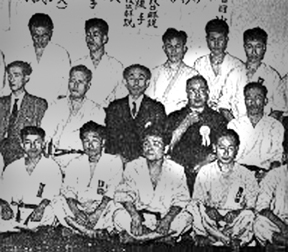 The negative perception of Fujita Seiko in the western martial arts community, resulting from Fujita's unintended association with fraudulent Koga ninja, would have come as a great surprise to both Fujita and his contemporaries. The historical record shows that Fujita was a respected martial artist and counted among his friends many of the martial arts luminaries of his day. Among them were Mabuni Kenwa, founder of Shito-Ryu Karate-Do; Taira Shinken, founder of Ryukyu Kobudo Honzon Shinko Kai; and Konishi Yasuhiro, founder of the Shindo Shizen Ryu and a Nanban Sato Ryu Kenpo student of Fujita's. The circle also included many other Okinawan masters, including Funakoshi Gichin, founder of Shotokan Karate-Do. Interestingly, while Fujita is shunned by legitimate modern Ninjutsu practitioners, those connected to the modern Okinawan arts are eager to associate their martial arts lineages with him. For example, the modern lineage chart of Ryukyu Kobudo places Fujita among the martial arts icons, Taira, Mabuni and Funakoshi. The lineage chart mentions him as "Fujita Seiko (Ninja)," a measure of the mystique that his connection to the Koga ninja tradition gave Fujita among his contemporaries and their students.
The negative perception of Fujita Seiko in the western martial arts community, resulting from Fujita's unintended association with fraudulent Koga ninja, would have come as a great surprise to both Fujita and his contemporaries. The historical record shows that Fujita was a respected martial artist and counted among his friends many of the martial arts luminaries of his day. Among them were Mabuni Kenwa, founder of Shito-Ryu Karate-Do; Taira Shinken, founder of Ryukyu Kobudo Honzon Shinko Kai; and Konishi Yasuhiro, founder of the Shindo Shizen Ryu and a Nanban Sato Ryu Kenpo student of Fujita's. The circle also included many other Okinawan masters, including Funakoshi Gichin, founder of Shotokan Karate-Do. Interestingly, while Fujita is shunned by legitimate modern Ninjutsu practitioners, those connected to the modern Okinawan arts are eager to associate their martial arts lineages with him. For example, the modern lineage chart of Ryukyu Kobudo places Fujita among the martial arts icons, Taira, Mabuni and Funakoshi. The lineage chart mentions him as "Fujita Seiko (Ninja)," a measure of the mystique that his connection to the Koga ninja tradition gave Fujita among his contemporaries and their students.The level of respect Fujita commanded among his contemporaries is evidenced in the fact that prominent martial artists directed their most promising students to train with Fujita. Two of these students in particular, Inoue Motokatsu and Iwata Manzo, would become grandmasters in their own right, and their experiences are vital in instructing us as to the level of regard in which Fujita's abilities were held by his contemporaries. Additionally, their training under Fujita provides us with evidence of Fujita's intentions regarding the preservation and transmission of his various martial arts systems, with particular focus on his Koga Ryu Wada Ha. It is from this perspective that Fujita's association with prominent martial artists and his training of Inoue and Iwata are especially instructive to us, particularly as relates to the fate of his Koga Ryu Wada Ha. That Fujita was the legitimate inheritor of the Koga Ryu Wada Ha was accepted by his contemporaries, and by the Bugei Ryuha Daijiten, both of which provide credible support for Fujita's claim that he inherited a legitimate and unbroken Ninjutsu lineage. Additionally, Fujita, as early as 1936, had written a book called Ninjutsu Hiroku, (Ninjutsu In depth) which demonstrates that at least 30 years before his death, and decades before Japan's own ninja boom, Fujita was claiming to have inherited the Koga Ryu Wada Ha system as its 14th soke. Moreover, in light of his death on 4th January 1966, the relevance of the debate as to whether Fujita truly inherited a legitimate Ninjutsu lineage becomes moot, unless it can be demonstrated that Fujita designated a successor. The relevant question then becomes whether the historical record supports the claim of Koga Ryu Wada Ha's inheritance by anyone of the numerous individuals who have concurrently claimed to be Fujita's lineal successor. |